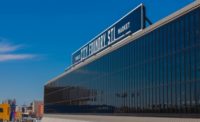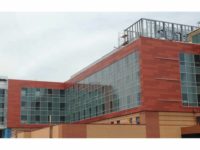American Made, Sustainability Among Popular Trends with Building Enclosures






As years and decades come and go, so do trends throughout any industry. The building enclosure industry is no stranger to this either. Preferences change over the years in the types of metals used, the looks of facades and even where products are sourced from. For example, a driving factor in sourcing products and systems has historically been price, regardless of where they were sourced from. However, there has been a shift away from this tribal thinking to focus more on where products are sourced from and the quality of the products.
Made in the U.S.A.
One of the current trends is due to the subject that has dominated headlines for all of 2020, COVID-19. Because of the pandemic, the world is changing. Importing products from across the world is an idea that is leaving companies hesitant and concerned. This is causing more contractors and construction managers to use domestically sourced products.
Using products that are created domestically reduce the risk of delays and improve the lead times with construction projects. This includes all facets of the building enclosure industry, including glass, metal, aluminum, even down to bolts and hardware for the accessories and the components. Time is money in construction, so if a contractor can get something sourced domestically in four weeks versus sourcing a product across the sea for 12 to 14 to 16 weeks, it will help the efficiency of the project.
Some companies are willing to pay more for products made in the U.S. There is also an opportunity for fabricators, providers and suppliers in the U.S. to bring old components back to their shop or debut a new product. This could open up a lot of opportunities for fabrication and production facilities in the U.S. There are some products that are challenging to get domestically, and they are only sourced at fabrication facilities in Germany, Spain, China, etc. There are a lot of opportunities for those companies to bring those products back here and produce them in America.
From a consumer standpoint, there is a lot of pride in buying and using products made in America. The pride aspect and the functional aspect provide qualitative and quantitative impacts of buying domestically versus sourcing them from overseas.
Within the industry, people are very prideful right now with American made, American built and American sourced products. It is hard to quantify the impact, but there is a positive impact and it is hard for other companies not to get on that band wagon.
Putting money back in the companies that are based in the U.S. is a catalyst of positive economic growth and betterment. Construction owners are seeing that as well because they are the ones that are willing to pay a little more to source products domestically.
When it comes to risk, there have been some instances of products being quarantined or held for an extended period of time. If a company is waiting on a component to build a system to go on a building and that component is sitting on a boat in quarantine, that will hurt the project’s schedule and possibly its budget. The construction company does not have any control over it. Control is a big advantage of sourcing that material domestically because if a person can control it, they have more ownership over the outcome of when they get it.
One of the first questions being asked by the architect, owner or general contractor these days is where is the product coming from? They want to know for a number of reasons. It could be for risk, control, schedule, cost, logistics or anything else.
Sustainability
There has also been an increase in the focus on understanding what the building components’ impact is on the building itself. While energy efficiency and sustainably have been top of mind for at least the last decade, people are now looking at it on a more micro level.
Many new questions are now being asked. Are these products sustainable and are they contributing to my building being sustainable? Are the products smart? These products meet code, but what would it take to be code plus?
Buildings, whether new or renovated, continue to strive for Leadership in Energy and Environmental Design (LEED) certification from the U.S. Green Building Council (USGBC). These standards provide guidance on how to design, build or maintain an energy-efficient and sustainable structure.
Although the USGBC does not certify, promote or endorse products’ specific companies, products do play a role in this process and can help project teams earn points toward LEED certification. The products do not earn projects points, but products can help project teams meet the requirements that are determined by the LEED standards.
Besides LEED certification, some cities and companies are utilizing additional platforms to improve sustainability. 25 cities throughout the U.S. were selected to take part in Bloomberg Philanthropies’ Climate Challenge, which is helping cities set and surpass climate goals by taking action in the two highest-emitting sectors in cities: buildings and transportation. The program helps cities accelerate their efforts to limit climate change and promote a sustainable future for their residents. The program originally sought out 20 cities to participate, but the program was expanded to 25 cities due to the strength and amount of the applications it received.
Through the program, mayors of the cities chosen will implement proven climate solutions and innovations that will help grow the economy, protect public health and improve the quality of life for citizens in their cities.
Metal Design
Specific to metal design, one of the trends seen right now is the use of natural metals. Some of the big-name providers get these products overseas, but there are some great options for these products domestically that are being used more in design these days.
All-natural metals, such as aluminum, copper steel and zinc, are found in a variety of architecture projects around the world. These metals have a long lifecycle, can be recycled and possess great durability. While these metals have been used in architecture projects for decades, architects, contractors and designers continue to choose these metals for commercial—and even residential—projects.
Pre-weathered steel and stainless steel have been popular choices in recent years. Pre-weathered steel is created to eliminate the need for painting the steel. If exposed to the elements for an extended amount of time, the steel forms a rust-like appearance. This creates a patina coating that prevents future corrosion.
Stainless steel has become one of the more used materials in the world. Its strength and durability have made it ideal for both structural and design uses. It can be found in buildings of any size, including skyscrapers.
As 2020 approaches its end, many companies will continue seeking out domestic products, even if they cost more, to ensure they get their products on time so that projects can stay on schedule. Sustainability continues to be a major focus for them as well, but they are taking it to even greater heights. When it comes to the aesthetics of new or renovated buildings, natural metals, pre-weathered and stainless steel remain popular choices as they have been in recent years.
Looking for a reprint of this article?
From high-res PDFs to custom plaques, order your copy today!










